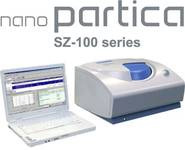The new SZ-100 series instruments from Horiba analyze key particle physical properties including size and zeta potential. In addition, it can be used to determine protein and polymer molecular weight, and second virial coefficient (A2).
Particle size analysis is performed by dynamic light scattering (DLS). Zeta potential is measured by electrophoretic light scattering. Molecular weight and A2 are analyzed by static light scattering using a Debye plot. Typical applications include nanoparticles, colloids, proteins, biomolecules, and emulsions.

The SZ-100 is the only instrument available capable of performing size measurements at both right angle (90°) and backscatter (173°). This unique feature provides maximum sensitivity and allows the user to optimize measurement conditions for all possible sample types. Particle size measurements are performed in a variety of cells at volumes down to 12 ìL. Zeta potential measurements are made in either disposable cells for aqueous samples or dip cells for organic and biological samples. The unique disposable cells using carbon electrodes can typically measure hundreds of samples before requiring replacement. As little as 100 ìL is required for zeta potential determination.
An automatic titrator is available for iso-electric point determinations of zeta potential vs. pH, or studies investigating optimum surfactant concentration for formulation or processing.
Particle size measurements can be made from 0.3 nm - 8 ìm at concentrations from 0.1 mg/mL (lysozyme) to 40 wt percent depending on sample properties. Zeta potentials from -200 to +200 mV can be analyzed manually or with the auto titrator. Molecular weight of large molecules is measured from 1x103 to 2x107 g/mol.
The Horiba SZ-100 Nanoparticle Analyzer